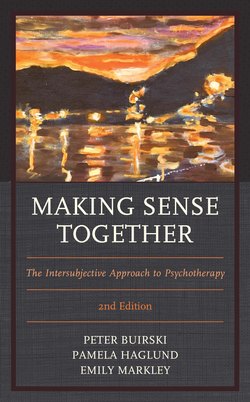Читать книгу Making Sense Together - Peter Buirski - Страница 10
На сайте Литреса книга снята с продажи.
Subjectivity and Intersubjectivity
ОглавлениеPsychoanalytic theories of mind consist of comprehensive explanations of human behavior and motivation. Such theories seek to account for normal and abnormal development at both the population and individual levels, but these abstract and global ideas can seem distant from our personal, moment-by-moment, lived experience. Intersubjectivity theory has reformulated psychological concepts of why people act, feel, and behave the way they do in terms that directly capture our internal and relational experiences. This book discusses these compelling ideas and demonstrates how these concepts apply to the practice of psychotherapy. This chapter unravels the paradox that intersubjectivity presupposes subjectivity and subjectivity presupposes intersubjectivity.
A central organizing concept of intersubjectivity theory is that our experience of ourselves is fundamental to how we operate in the world. Our subjective experience is the phenomenology of all that one might be aware of at any given moment and much of what is out of awareness, as well. Over time, the complex interweaving of individual abilities and temperament, relational configurations with caregivers during infancy and childhood, and the lucky or harsh realities of one’s life circumstances converge to form patterns. These patterns of experiencing oneself and the world describe our subjective, personal reality and become structured as our organizations of experience. In treatment we hope to understand these patterns in the context of a relationship that becomes a new lived experience and the basis of new organizing patterns.
All psychoanalytic theories of personality begin with some conception of the central motivational constructs that underlie both normal and pathological human behavior. For example, Freudian theory sees human motivation as deriving from the instinctual drives of sex and aggression, while modern relational theories typically view motivation as springing from some need to create or maintain bonds to others.
Along with other modern relational theories, developments in self psychology and intersubjectivity theory point to the inadequacy of earlier psychoanalytic conceptions of motivation to explain human psychology. In work that has had a strong impact on intersubjectivity theory, Lichtenberg (1989) has observed that “motivations arise solely from lived experience” (p. 2). Human motivations, whether for food, sexual gratification, or attachment (Lichtenberg posits five motivational systems), serve to promote, maintain, or restore a fundamental sense of self-cohesion. “Lived experience is about how we human beings consciously and unconsciously seek to fulfill our needs and desires by searching in potential events for affects that signal for us that experiential fulfillment” (p. 2).
By affects we are referring, in everyday language, to how one feels. Affects are emotions that refer to a subjective “state of mind or condition of arousal” (McWilliams, 1999, p. 103). As signals, emotions alert us to our needs and our desires and, along with our sensory perceptions and our beliefs and ideas, constitute the “stuff” of immediate experience. Emotions guide us and inform us about matters of survival, safety, and satisfaction. We now recognize the important role of affects in organizing experience, and therefore as the core of subjective experience. From this perspective, the central motivational construct for intersubjectivity theory now stresses the role of affect rather than drive.
Lichtenberg (1989) further states, “The vitality of the motivational experience will depend initially on the manner in which exchanges between infants and their caregivers unfold” (p. 2). He points us to the contextual nature of our emotions. Whatever our needs and the emotions associated with them, we initially experienced them in the earliest caregiving relationships. As Stolorow and Atwood (1992) make clear, “The ‘affective core of the self’ (Emde 1983) derives from the person’s history of intersubjective transactions, and thus the shift from drive to affect resituates the psychoanalytic theory of motivation squarely within the realm of the intersubjective” (p. 26).
We have begun this book with a focus on affectivity and will devote part of chapter 4 to the subject because it is both a central organizing construct in intersubjectivity theory and the fundamental organizer of subjective experience. The generation, regulation, and integration of affect occur within an intersubjective context, and we will trace the thread of affectivity as it is woven throughout intersubjectivity theory and treatment.
Psychoanalytic theories can be characterized by their distinctive domains of inquiry, treatment aims, and investigatory stances (Stolorow et al. 1994a). This chapter examines intersubjectivity theory from the perspective of its particular domain of inquiry, treatment aims, investigatory stance, and the central role of affectivity in each of these areas.
